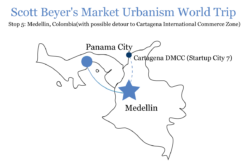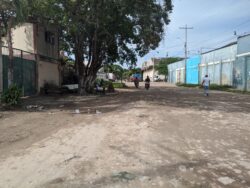“Zona Francas”: A Step Towards Latin American Freedom
The region’s trade-focused SEZs should take a further step and deregulate land use.
Cartagena, Colombia is known as a tourist beach city. But go to the south side, as I did one day last October, and you’ll find its other half. The area’s full of zona francas—trade liberalization zones designed to attract multinational corporate factories. It was the sort of turbocharged industrial landscape I’ve come to associate with Latin America, full of smokestacks, shipping containers, cement trucks and exhaust-spewing motorbikes. There are also, around those factories, dangerous slums. Those who migrate to work in the zones can’t find housing within, so they “invade” surrounding land, building neighborhoods that are illegal, substandard and often gang-controlled. This speaks to the promises and perils of LatAm zona francas and how they might be reformed.
Zona francas (which are sometimes called zona libres) exist to facilitate trade. They’ve become staples across LatAm, as noted in Adrianople Group’s “Open Zone Map”, with hundreds of Special Economic Zones (SEZ), Free Trade Zones, and similar designations.
In the Dominican Republic, free zones have been legal since the late 1960s. The U.S.-Mexico border, unsurprisingly, hosts a number on the U.S. side. In 2020, the Mexican government opened free zones on its southern border also, allowing for lower taxes on goods from Central America. Panama hosts a number of free zones along its canal. Honduras is also home to free trade zones, distinct from its more ambitious ZEDEs, as are most other LatAm nations. Even Cuba has one.
Colombia has 120 zona francas, which employ over 130,000 people, notes Invest in Colombia. Free zones are even located within major cities. One in Medellin is a public-private partnership whose benefactors include the coffee industry, and primarily functions as a convention center. Others, like Cartegna’s, are more industrially focused, housing stuff such as the refinery for the Colombian energy company Ecopetrol.

These Colombian zones don’t charge import taxes, and charge a “one time” 20% income tax—15% lower than the rest of the country. Other zona francas mirror the ones in Colombia, charging lower taxes (sometimes down to 0%) and looser regulations for trade, employment, and more.
The broad benefit is improved access for firms domestic and international, and thus more economic activity. The Dominican Republic’s free zones amounted to over 4% of the country’s GDP by the early 1990s; and created 140,000 jobs. In Uruguay, “free zones employ approximately 15 thousand people,” reports InMove Logistics, and account for 5-7% of GDP, despite consuming a micro-fraction of national land mass.
But the primary focus of these zones is industry (and sometimes retail, such as shopping malls). The liberalization has not extended to housing. None of the dozens that I’ve visited or rode by resemble a “city”. This is a flaw, as lack of housing harms the profitability of these zones and the welfare of their workforces.

And it’s a flaw caused by regulation. Colombian zona franca laws specify “industrial user of services” and “commercial user” categories, and the latter can only take up 15% of the zona franca’s land area. Uruguay’s free zones are similarly restricted; when I visited Parque de las Ciencias, a zona franca near Montevideo, general manager Enrique Buero said half of the land area was blocked off from development because the zone was subject to county preservation laws. Buero also noted zona francas throughout LatAm often have anti-housing laws.
These laws are particularly problematic, creating settings like what I found in Cartagena. For example in Quito, a northside Coca-Cola factory led to a massive surrounding favela. North of San Pedro Sula, Honduras, a half-dozen zones yielded a sprawling number of settlements with dirt roads and roaming livestock. It’s widely-known as one of Honduras’ most dangerous areas.
A nearby community called Ciudad Morazan—which is using the more sophisticated ZEDE framework—will build housing to accompany its warehouses. Morazan’s management told me that this is due in part to make the philosophical point that blue-collar workers don’t have to go home every night to substandard conditions.
This speaks to a potential reform path for zona francas. Last month I wrote in this cross-global series about how Honduras’ ZEDE framework (which is still in legal limbo) enabled city-building opportunities not allowed by traditional SEZs. Morazan and Prospera (another ZEDE on Honduras’ Roatan island) are becoming low-tax “startup cities”, because the ZEDE framework grants them some governing autonomy, such as deregulated land-use.
It’d be good if other LatAm countries passed their own ZEDE-style legislation. The benefits of their zona francas are already clear—as these small territories become bastions for corporate relocation, trade and GDP growth. They’re further proof (as if more were needed) that liberalizing areas for business attracts business. But to unlock their true potential, they should expand beyond narrow sectoral focuses. Enabling housing construction will make housing more affordable and better quality for workers, and broaden the productivity of these zones.
All images credited to Scott Beyer and The Market Urbanist.
Catalyst articles by Scott Beyer | Full Biography and Publications
